The Pacific Southern Line Islands are a benchmark for pristine seas
The National Geographic, September 2014, reports: “If an alien had just one day on Earth and wanted to see a coral reef,” says National Geographic Explorer-in-Residence Enric Sala, “I would show him Millennium Atoll.”
What that alien would see is one part of perhaps the most pristine archipelago in the Pacific: five remote isles named Caroline (commonly called Millennium), Flint, Vostok, Malden, and Starbuck, together known as the southern Line Islands. The waters around these uninhabited specks of land, located 1,500 to 2,100 miles south of Hawaii, are among the last truly wild places in an overexploited ocean.
Now that area will be protected. The Kiribati government recently declared a 12-nautical-mile fishing exclusion zone around each island, part of an effort led by Sala, a marine ecologist, and National Geographic’s Pristine Seas project to document and conserve what’s left of the planet’s least spoiled marine environments. The creation of a southern Line Islands marine preserve is something Sala has been hoping for since he led an expedition to the region in 2009. “These islands help us understand what ‘pristine’ means,” he says. “From every perspective — coral density, fish biomassbiomass The amount of living matter. This is therefore a different measure to numbers of organisms. So, for example, there is much more biomass in 1 elephant than there is in 1000 fleas and there may be more biomass in 100 large cod than you would find in 150 small (because of over fishing) cod., the number of top predators, the biodiversitybiodiversity Biological diversity in an environment as indicated by numbers of different species of plants and animals. — their ecological story is amazing.”

A World Apart: The Southern Line Islands Photograph by Brian Skerry
During the 2009 expedition divers spent more than a thousand hours underwater around the five islands. What they found astonished them. On some reefs the corals were so dense they covered 90 percent of the seabed — vastly more than the 5 to 10 percent coral coverage found in the Caribbean.
The scientists were similarly surprised by the health of the crowded coral communities. Across the Pacific, water-temperature spikes caused by El Niño weather events have killed off massive amounts of coral. But the reefs of the southern Line Islands seem to be unaffected by bleaching or disease. “We know this region was hit hard by ocean warming, and we expected to see coral death, but the reefs were untouched — perfect,” says Sala.
Corals tend to be resilient in places where other elements of the marine ecosystem are flourishing too. In parts of the lagoon at Millennium, densities of giant clams reach up to four per square foot — an almost unheard-of abundance for creatures highly sought for their meat and shells. “Giant clams have been decimated in most atoll lagoons,” says Sala. “In Millennium lagoon the reefs are paved with clams.”
The most common species, Tridacna maxima, is better known by a name that seems to contradict itself: the “small giant clam.” These molluscs are a little longer than an American football, but they are dwarfed by individuals from the largest clam species, Tridacna gigas, which can exceed four feet in length. At first glance the small giants look like they’re wearing blue, indigo, green, or another shade of lipstick. In fact the colour comes from pigment cells inside their fleshy mantles, which protrude like wavy lips when the shells are open.
The giant filter-feeders act as water purifiers. Microbiologists on the expedition measured bacterial concentrations at every atoll they visited and found Millennium’s clam-filled lagoon to have the lowest count. Bacteria can cause diseases in coral, fish, shellfish, and crustaceans such as crabs. Low concentrations in seawater are an indication of a healthy marine ecosystem.

The Line Islands were so named because they straddle the Equator, known to sailors as “the line.” Malden Island is largely barren above water but possesses an underwater luxuriance that attracted scientists from National Geographic’s Pristine Seas project.
The southern Line Islands haven’t always enjoyed such splendid isolation. In the 19th and 20th centuries several were exploited for natural resources like guano and coconuts, and in 1957 the British government conducted atmospheric nuclear tests near Malden Island. But none of that human impact is evident underwater. Sala and his team recorded 325 fish species in the southern Line Islands, and estimates of fish biomass (total weight) were some of the highest ever reported from a coral reef. At several locations divers saw endangered Napoleon wrasses, one of the world’s largest reef fish. Also known as the humphead wrasse because of a pronounced bump on the forehead of mature adults, these fish can grow to more than six feet long — large enough to sometimes have their own escort fish, as sharks and large rays do.
The waters around the islands showed the “inverted biomass pyramid” of healthy reefs, in which top predators, as measured by cumulative weight, account for most of the fish — at Malden Island, more than 70 percent. Predator dominance had been previously reported at Kingman Reef, in the northern Line Islands, on an earlier National Geographic expedition. (See “An Uneasy Eden,” National Geographic, July 2008.)
“It’s a seascape of fear,” says photographer Brian Skerry, who was on the expedition. “Everything is either hunting or being hunted.”
On one dive at dusk — what Skerry calls the “shark witching hour” — he found himself hemmed in by grey reef sharks. “There must have been 60 of them,” he says. “I was trying to photograph in a three-sided coral head, and one of them would come in really close. Usually a shark will go away, at least temporarily, if you fend it off, but these guys were doing a quick 360-degree turn and coming right back, and behind that one were five more, and behind them another ten, and you could see them jockeying for position. In 36 years of diving I’ve had some dicey moments with predators, but I’ve never felt physically hunted, as I was here.”
That abundance of predators could easily be lost. Sala reckons it would take just a few months for a large vessel to strip the reefs of sharks, which are hunted for their fins. The health of the ecosystem could then quickly plummet. Without top predators, midrange predators would likely proliferate, herbivore numbers tumble, and algae overtake the coral.
At Millennium Island divers saw two sharks with stainless steel hooks in their mouths, one of them trailing a length of fishing line. A French sailor moored in the lagoon said he had seen a long-liner working offshore.
Kiribati’s move to protect the islands’ marine life could help prevent that kind of activity, though enforcement won’t be easy. Patrol vessels and surveillance aircraft are expensive in such remote places. Modern technologies, including satellite monitoring and vessel-tracking systems, can alert authorities to the presence of poachers, but stopping them before they inflict ecological damage will be a challenge.
Other threats may be more daunting. Tropical reefs face a climate-change triple whammy: sea-level rise, higher surface temperatures, and ocean acidification. Any one of these can be damaging to reef-building corals; the combined impact could be devastating. Some marine scientists have warned of the imminent and widespread disappearance of tropical reefs.
Rising sea levels also threaten the survival of small island nations. Kiribati’s president, Anote Tong, has warned repeatedly that his country, built on coral reefs, could become uninhabitable by 2050, and that its more than 100,000 people might have to abandon their homeland. The preservation of reefs is vital to his people. “The best thing we can do to buy time is to make sure reefs have as much structure as possible — that the ecological machine has all its parts,” says Sala. “The more complete a reef is, the more resilient it will be to climate change.”
Source: The National Geographic, September 2014. For the full text see: http://ngm.nationalgeographic.com/2014/09/southern-line-islands/warne-text

























